LakeChamplainAngler.com |
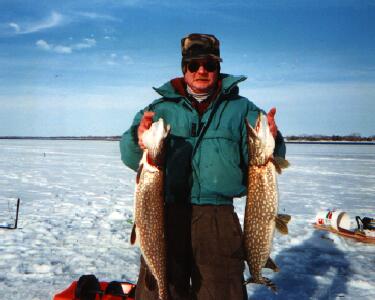
|
|
Finding The Fish In the winter locating schools of fish can be difficult. If you don't have a good spot in mind, look for tight groups of fishermen or tents in a general area. It's likely that some of these are die hard locals who fish often and know where the fish hold. If you pass by an area on a weekend, a few hours after sun up, the serious guys will already be there. This should give you a clue as to where to begin. These same areas usually have a parking situation that allows room for a number of vehicles and provides access without trespassing on private property. After finding a general area to fish, proceed onto the ice with caution. Try to make as little noise as possible when approching your targeted spot or passing by other fishermen who are already set up and catching fish. Remember too, it is not necessary to crowd another person. There are 120 miles of lake out there. Use a little imagination! Our theory for perch fishing is to cut one hole at a time and set a time frame for waiting out the fish. Cutting a bunch of holes in an area drives schools away! We recommend a sharp 4 or 5 inch auger to cut a perch hole. A chisel pounding on the ice is too noisey in our opinion and so is a power auger. Be patient, especially if you are using live bait or minnow chum to draw fish to your hole. On the other hand, don't spend hours in a hole that is not producing. For perch, fishermen should present their bait very close to the bottom. Water is most dense at 39.2 degrees. When the big pond is completely frozen, that 39.2 degree water will rest on the bottom of the lake. The water in the frozen lake will range from 32 degrees (directly under the ice) to 39.2 degrees (at the bottom of the lake). Fish, being cold-blooded, will congregate and forage in this dense, warm layer. Keep in mind that this rule is a general guide-line. Some fish like crappie, smelt, lakers or salmon frequently "suspend" some distance off the bottom when variables like oxygen levels or forage come into play. Northern pike are mostly shallow bottom dwellers, but they also look up toward the water/ice surface for their prey, so present pike bait suspended a couple feet off bottom or higher. |
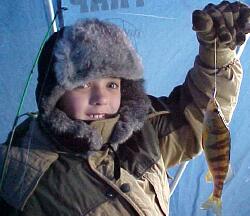 |

|
|
Tackle Tips There are many choices of ice fishing jigs available to the fisherman. The Islander Lure Company makes a banana shaped panfish jig that happens to be our favorite for perch. Can you tell which of the Islander jigs pictured above is a bootleg version? Right, its the pink one, second from the left. This year Islander has improved on their jigs by using a harder paint with a seemingly higher gloss finish. They have also come out with a brown and rainbow trout version like the jig on the far right. Another favorite and unique ice fishing lure is the "bibit", a heavier jig sometimes found with a barbless hook. Used by many fishermen in shallower water, it is designed to catch and release fish on the ice, in one sweeping motion, without actually touching the fish. This takes some practice! |
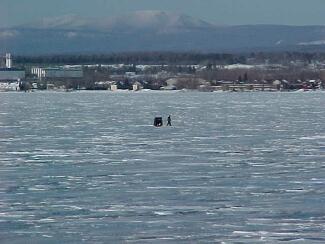 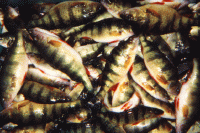
|
|
Safty Tips Walking on any ice surface can be difficult. We recommend a pair of creepers or spikes for the boots. We've seen many a sober fisherman tumble on ice that is uneven, wet or slightly covered with snow. Pail goes up, they go down. If their head hits the ice the result can be serious! Here are a few more things to remember. Ice along shorelines is often soft, cracked, tilted or any combination of these hazardous possibilities. Use care when stepping out on new ice. If it is hard, experts claim a good 3" or better will hold the average man. To test the thickness, reach down and grab the ice through a hole drilled in shallow water, hold your hand steady and measure the grip using a generous inch. Stay away from ice this thin if it is covered with snow!!! You won't be able to see changes in thickness etc. We like 4 inches. Remember, there could be thinner, weaker spots near current, weed beds, rock piles or springs. Be cautious as you proceed on the ice. Watch for problems like pressure cracks or thin areas. When near open water be aware of wind where it could cause the ice you are standing on to drift away from land. High winds combined with a strong current on Lake Champlain have resulted in fishermen being helplessly set adrift in years past. |

|
| * Despite all the precautions that anglers take, a few go through the ice each year, and all ice anglers should know something about rescue techniques and first aid for hypothermia. Drowning is one immediate danger, But usually the victims are able to keep their heads above water by clinging to the edge of the broken ice or to floating gear. Most fatalities are caused by hypothermia, a rapid, drastic lowering of body temperature which causes loss of the use of limbs, disorientation, unconsciousness and, finally, heart failure.
Victims have only a few minutes to extract themselves from the water before their hands become too stiff to use. Then they must depend on rescue by others. Survival time in the water varies from about 20 minutes to as much as 90 minutes. If the victim is large and wearing a lot of clothing, and if he remains still, keeps his head and neck out of the water and draws his knees and arms into his chest, he will minimize heat loss and lengthen survival time. A thin person, or one who struggles, will succumb to hypothermia more quickly.
Some anglers carry spikes in easy-to-reach pockets or on strings attached to the sleeves of their coats. Dug into the slick, wet ice at the edge of a hole, they can help a victim crawl out of the water. In an emergency you can also get a grip on the ice with a pocket knife, a gaff or the ice cleats from your boots. Once out of the water, crawl or roll back along your path to safe ice.
If you see someone go through the ice, be extremely careful attempting a rescue. You don't want to end up in the water, too. Reach for the victim with your ice auger, fishing poles or anything of adequate length that lets you remain out of danger. Remove your belt or other clothing and fashion a rope to reach the victim. If more people are available to help, form a human chain to reach the person in trouble.
When the victim is removed from the water, it is imperative that first aid begin as soon as possible. Until the victim is removed from the cold environment, body temperature will continue to drop as the vital organs cool, adjusting to the colder surrounding tissue.
Generally, in mild cases of hypothermia first aid procedures consist of shelter, dry clothing and, only if victim is conscious and alert, hot liquids. Under no circumstances should the victim be given alcoholic beverages which diminish shivering, thus reducing heat production. Alcohol also causes dilation of surface blood vessels, causing more heat loss.
Do not rub the victim's skin. A condition called after-drop is at least a potential problem in all cases of hypothermia. After-drop is the continued decline of core body temperature even after rescue as the relatively warm core continues to lose heat to the cold outer body tissue.
The risk of after-drop is increased by premature exercise or warming of the extremities. The physiological result of a sudden influx of cold blood may cause the core temperature to drop to a level that could be fatal, even after a successful rescue. Insulate the victim's trunk, head and neck from additional heat loss and transport them to a medical facility as soon as possible.
Fortunately, rescue and first aid are very seldom necessary. However, since the sport is constantly attracting newcomers and since even veterans are subject to occasional human error, it's best that anglers be prepared for any unexpected situation and learn emergency measures even though they may never have to apply them. * From Nebraska Game and Parks Commission's Ice Fishing Guide The photo below was taken on 6 Jan, 2001 at Point Au Roche shortly after a man was pulled from the water by Captain Mick and another fisherman. The man was submerged up to his shoulders and was hanging on to the ice for only a few minutes. When he was pulled from the fridged water he appeared totally exhausted. Needless to say, he didn't go back for his pail. |
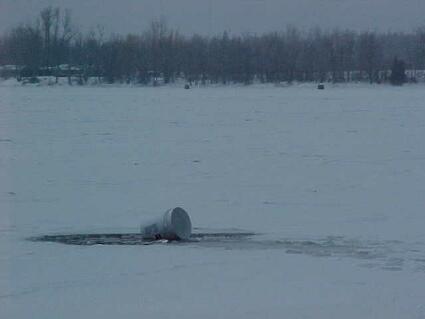 |
Ice Fishing Links |
|
Ice Fishing Gallery
Ice fishing photos |
|
Ice Fishing Locations
Ice fishing spots |
|
Guided Ice Fishing
Ice fishing guides, and shanty and equipment rentals |
|
Home
Back to the Lake Champlain Angler home page... |
- A MicMaynard Web Production - |